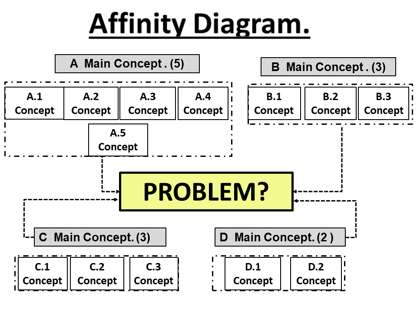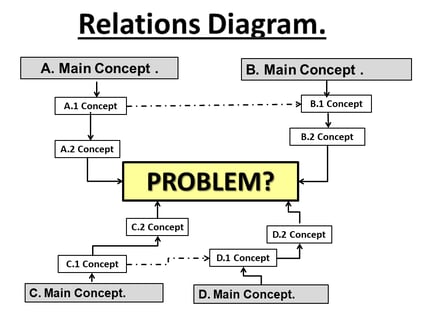8 Innovative Problem Solving Steps to Organisational Effectiveness
Lacides Castillo
Have you ever been frustrated by not having solved a difficult problem the right way or worried that you are wasting resources while providing little in the way of organisational effectiveness? This type of situation happens more than you might think and it has certainly happened to me. On top of that, nowadays there is an explosion of information that complicates both a problem's context and understanding, thus making the right decision becomes even more difficult.
For a business to survive and grow in a competitive global market requires the right focus to understand and satisfy the customer need whilst also approaching problems with a specific organisational culture, creativity and innovation. To do this, a conversation needs to be had about identifying customer pain points, desires, worries, etc...which help to shed light on the right customer context and aid in the application of a more effective Quality Function.
Any data you recieve from your must be analysed systemically into a logical mapping structure. On this very point, I assembled a Problem Analysis Technique shown in the e-book Reaching the right Solutions, found in Amazon, which analyses applying Quality Function Deployment (Q.F.D) to identify critical customer variables - this leads us to define value proposals for them.
Understanding customer pain points is just one of an organisation's key challenges and doesn't even factor in the problem of finding the right answers to identified business problems. If you are looking for specific answers to your questions then perhaps you should try taking this quick survey, which will help to provide you with the right type of information to answer your particular business problem - take the  .
.
Finding Innovative Solutions to Improve Organisational Culture, Creativity and Innovation
However, many Quality Managers are mainly focused on reducing variability and waste (reducing costs) on the Operations processes. I believe that some quality techniques are underused for adding the type of organisational effectiveness which creates greater value to customers and the organisation. For example, businesses could be harnessing the emerging analytics in marketing (coming from quality management tools) to better understand customer trends and identify ways to generate value for customers through surveys, site metrics and customer profiles.

The mentioned technique combines the Japanese approach (charts and figures) to understand the context of a problem with creative tools such as TRIZ and Creativity Workout by Edward de Bono to help gain innovative solutions.
Holistic Problem Analysis Technique: 8 Steps to Organisational Effectiveness
This Holistic Problem Analysis Technique consists of eight steps to creating organisational effectiveness and its application is illustrated in a real case study: Little Sustainable Prosperity in Venezuela and the Rest of Latin-America.
The 8 steps are as follows...
1.- Feeling Uneasy Regarding a Situation or Problem. At this step, you begin feeling uncomfortable with a given situation.
2.- Identify Your Real Problem. First, you focus on searching to get the right information; then you elaborate a rough mapping structure. This preliminary work leads you to ask the right questions and identify your real problem. For example, if you were asked either how to gain new employment or how to get new income, each would lead you to different routes. It is also said that a well defined problem contains 50% of its solution.
3.- Mark Compelling Paragraphs, on Reading the Text. You may mark book or article pages showing the most relevant concepts.
4.- Write Marked Paragraphs Into Post-its. As a suggestion, you may have different colored letters on those stickers where 'problem facts' are black, its 'causes' in red and 'identified proposals' in blue. Then, place those post-its on a smooth surface where the effects are at the bottom of the board, the causes on an upper level and the proposals on top of those reasons. This scheme gives you a rough idea of the whole problem's context.
5.- Affinity Diagram to Determine Problem's Context. Then, you gather those post-its, with similar concepts into groups and name each one. Those clusters surround the problem statement box. Affinity Diagrams help you to arrange problem effects and then, their respective causes.
6.- Relations Diagram to Determine a Problem`s Context. This procedure is the most powerful way to analyse problems. My experience tells me that this method follows the Affinity Diagram. I recommend you only use group names when constructing the first Relations Diagram according to the Cause >>> Effect criterion. In this way, you can go on creating a more detailed Relations Diagram. In this phase, Relations Diagrams also display both effects and their respective causes.
Below you can see an example of an Affinty Diagram and a Relations Diagram...


7.- Affinity and Relations Diagrams to Attack Causes. (Proposals). Both Diagrams were applied to identify corrective actions to attack a problem's causes. In this way, it offers preliminary solutions to our case study problem.
8.- Apply Creativity Tools to Improve a Proposals Effectiveness. These powerful creativity tools are Creativity Workout; TRIZ and Ask Nature. They were applied to get innovative and efficient strategies and solutions for the case study. Finally, a brief prototype action plan was made as a means of following up actions.
I have been using the Japanese diagrams for over ten years and the creativity tools provided for more than three years in my profession.
Another use of this technique was to identify the reasons why a given company had Little Innovation practice. The two main reasons found were that top management had not given priority to that and lacked market and competitor information.
You can work with this technique as an individual or as a team to tackle complex situations. If you use this method frequently, you may improve your analysis and creativity and as a result, may feel more comfortable with uncertainty.
Finally, it may be useful to read this e-book, if you had any further questions or doubts about the techniques employed in this article.
A word From Triaster
For more information on how to identify wasteful inefficiencies in your processes and improve organisational culture then we suggest downloading the successful  which will help you to create successful process maps first time by showing you...
which will help you to create successful process maps first time by showing you...
- How process mapping opens a pathway to successful business improvement in a real, measurable way
- How process mapping creates simplicity, accuracy and accessibility in an organisation
- An easy to understand process mapping methodology; and
- Tips for a successful process capture and mapping implementation
Related Articles:
The 7 Wastes Killing Efficiency: How to Identify Your Wasteful Processes
What are the 7 Wastes That are Killing Business Efficiency?
The 4 Essential Pillars of Business Continual Improvement [Infographic]
10 Reasons Why BPM is Important for Your Business Improvement Strategy
Written by Lacides Castillo
Lacides Castillo has worked as a quality manager advocating Total Quality Management principles and is currently working as a consultant with a main focus on improving business profits and growth.
